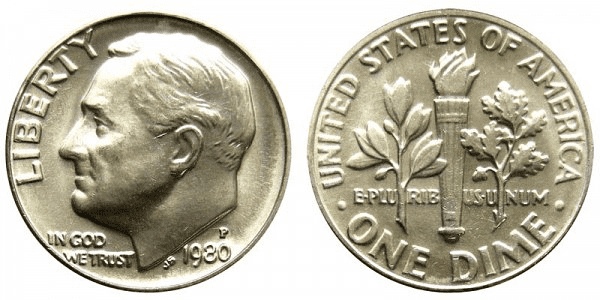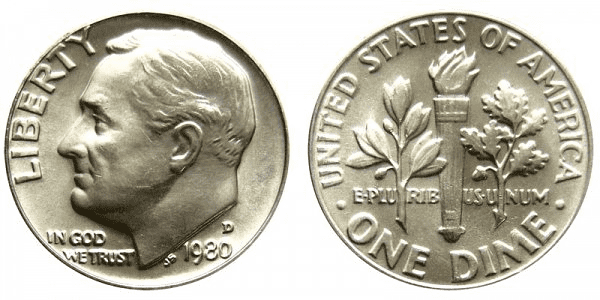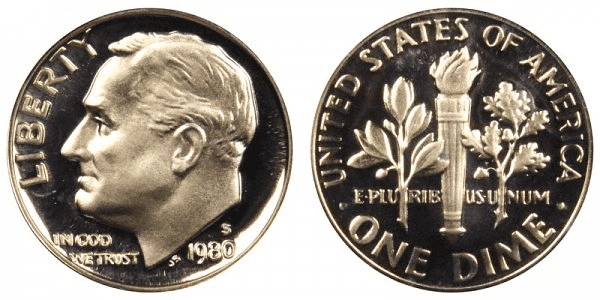What Is A 1980 Roosevelt Dime Made Of?
The Roosevelt Dime was produced by the US Mint in 1980. Because it is formed of clad metal, this coin has a solid copper inner core and a coating of copper and nickel on the outside (91.67 percent Copper – 8.33 percent Nickel).
Due to the 1980 Dime’s lack of silver content, these coins will be worth their face value absent special circumstances (such as errors or flawless condition). The obverse of the coin bears the words “Liberty, In God We Trust,” the year, and the designer’s initials, JS.
The reverse of the coin reads “United States of America, E Pluribus Unum, One Dime.” The coin’s reverse, or back side, features a torch in the centre surrounded by two branches. Franklin D. Roosevelt is shown on the coin’s obverse, or front, side.
The design had been used for more than 30 years by the time the Roosevelt dime went into production in 1980.
In 1946, the four-term president was a fitting successor for Weinman’s Winged Liberty design, and public opinion of the country’s longest-serving leader remained favorable as the generation he presided over survived the Great Depression and World War II into its later years.
1980 was a rather gloomy year with the Mount St. Helens eruption in Washington killing 57 people, the launch of CNN (Cable News Network) on June 1, and the murder of former Beatle John Lennon.
1980 Roosevelt Dime Varieties
1980-P Dime (No Mint Mark)
Year: 1980
Face Value: $0.10
Composition: 91.67% Copper and 8.33% Nickel
Weight: 2.27g
Diameter: 17.91mm
Thickness: 1.35mm
Edge: 115 Reeds
Minted in: Philadelphia
Mint Quantity: 735,170,000

photo source: www.usacoinbook.com
1980-D Dime
Year: 1980
Face Value: $0.10
Composition: 91.67% Copper and 8.33% Nickel
Weight: 2.27g
Diameter: 17.91mm
Thickness: 1.35mm
Edge: 115 Reeds
Minted in: Denver
Mint Quantity: 719,354,321

photo source: www.usacoinbook.com
1980-S Dime
Year: 1980
Face Value: $0.10
Composition: 91.67% Copper and 8.33% Nickel
Weight: 2.27g
Diameter: 17.91mm
Thickness: 1.35mm
Edge: 115 Reeds
Minted in: San Francisco
Mint Quantity: 3,554,806

photo source: www.usacoinbook.com
List of errors
There are no nationally recognized 1980 Roosevelt Dime errors, meaning that the errors seen in coins from this year will appear in individual cases.
Some common Roosevelt errors to look out for are listed below:
- Clipped Planchet: Clipped planchet dimes will have a missing part because of a misfeed during the minting process (often elliptical shaped). On a good day, clipped planchet dimes in Mint State condition can sell for $30!
- Blank Planchet: These unusual dimes are known as “blank planchet” because they are never struck with a pattern. These dime errors, which are blank on both sides, typically only reach values of a few dollars.
- Off Center Strike: Coins with off-center strikes have an improperly aligned obverse or reverse image. These coins frequently have irregular shapes and blank planchet spots. Values range from $10 to $20 per coin, depending on the severity of the off-center striking.
How Much Is A 1980 Roosevelt Dime Worth Today?
Due to the removal of any silver content, the 1980 dime’s face value is worth 5 times more than its melt value, which is a mere $0.024. This shows that 1980 Dimes’ true value is not their intrinsic metal value but rather their value as a collectible.
Due to this low value, plus the scarce number of errors found in this coin, the values for Roosevelt Dimes are pretty low, and you’ll only be achieving a few bucks (unless you’ve got an error) and for this, the coin will have to be in immaculate condition.
For example, 1980-P and D dimes are worth about $2.28 in MS65 condition, while 1980-S coins are worth $2.81 in their PR65 condition.
How Does The Grading System Work?
The Sheldon Scale is used by numismatists to provide a numerical value to coins. The Sheldon Scale goes from poor (P-1) to perfect mint state (P-1) (MS-70). Coins were originally evaluated using words to reflect their condition (Good, Fair, Excellent, Etc.). Unfortunately, coin collectors and dealers had different ideas about what each of these terms represent.
Professional numismatists joined together in the 1970s and established CoinGrading standards. These numismatists now assign grades at key places on the seventy-point scale, using the most regularly utilized numeric points in conjunction with the original adjective grade. The following are the most common coin grades:
-
-
- (P-1) Poor – Indistinguishable and probably damaged; if used, must have a date and mintmark; otherwise, rather battered.
- (FR-2) Fair – Nearly smooth, but without the damage that a coin graded Poor often possesses. The coin must have enough detail to be identified.
- (G-4) Fair – Inscriptions have merged into the rims in some areas, and important elements have been mostly erased.
- (VG-8) Very Good- A little weathered, but all of the primary design elements are visible, albeit faintly. There is little if any, central detail left.
- (F-12) Good – The item is very worn, yet the wear is even, and the overall design details stand out clearly. Rims are almost completely isolated from the field.
- (VF-20) Very Fine – Moderately weathered, with some finer features still visible. The motto or all letters of LIBERTY are readable. Both sides of the coin have entire rims that are separated from the field.
- (EF-40) Extremely Fine – Gently used; all gadgets are visible, and the most important ones are bold. The finer details are bold and clear, however, light wear may be seen.
- (AU-50) Uncirculated – Slight evidence of wear on the coin’s design’s high points; may have contact marks; eye appeal should be adequate.
- (AU-58) Uncirculated Choice – Slight traces of wear, no severe contact marks, almost full mint shine, and great eye appeal.
- (MS-60) Mint State Basal – Strictly uncirculated; no indication of wear on the coin’s highest points, but an unsightly coin with reduced luster, visible contact marks, hairlines, and other flaws.
- (MS-63) Mint State Acceptable – Uncirculated, but with contact scratches and nicks, little reduced shine, but otherwise appealing appearance. The strike is weak to average.
- (MS-65) Mint State Choice – Uncirculated with great mint shine, very little contact blemishes, and exceptional eye appeal. The strike is unusually severe.
- (MS-68) Mint State Premium Quality – Uncirculated with superb luster, no obvious contact marks to the naked eye, and exceptional eye appeal. The strike is quick and appealing.
- (MS-69) Almost Perfect Mint State – Uncirculated with perfect brilliance, a sharp and appealing strike, and extremely good eye appeal. A near-perfect coin with minor imperfections in the planchet, strike, and contact markings (seen only under 8x magnification).
- (MS-70) Mint State Perfect – Under 8x magnification, there are no tiny imperfections discernible; the strike is crisp, and the coin is perfectly centered on a beautiful planchet. Rarely seen on a coin, this coin is bright and whole, with original luster and exceptional eye appeal.
-
Where To Buy Or Sell 1980 Dimes?
A 1980 dime found in change bears absolutely no numismatic price, yet an unsuspecting bidder on an auction platform like eBay can end up paying $1–$5 for one. Coin dealers won’t buy or stock the date in circulated grades, even if they were offered.
For the same $1, a collector can buy a loose uncirculated specimen from a roll or a Mint Set.
A certified specimen of a coin in mint condition will cost a collector less money to buy than a coin that has been graded. Budget $5 to $10 for a gem example without the FB/FT indicator.
When it comes to 1980 Roosevelt dimes, unless you’re absolutely desperate for one, it’s probably best to just keep an eye on your pocket change instead, as one may turn up sooner or later.
FAQs
Is a dime from 1980 worth anything?
Unless it has an error the 1980 Dime really doesn’t hold much value.
How much is a 1980 error dime worth?
1980 error dimes can be worth around $10-30 dollars.
Does the 1980 dime have a mint mark?
Yes, unless it was minted in Philadelphia as this mint didn’t apply mintmarks to their coins at this time.



